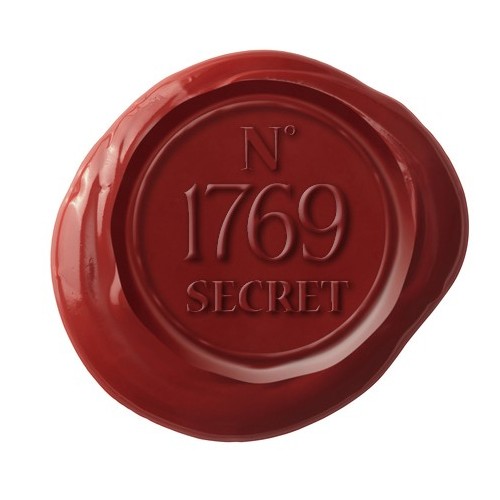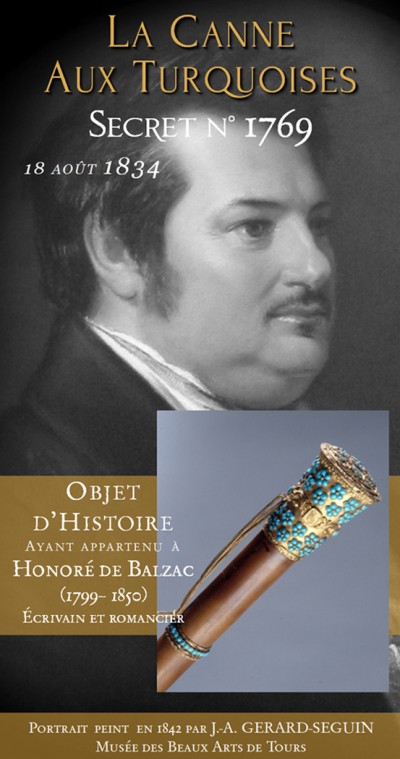
N° 1769
Balzac's Eccentric Turquoise Cane
Convinced of imminent financial comfort, Balzac bought this expensive accessory on credit.
The cane was ordered from the Parisian artisan Le Cointe (12 rue de Castiglione) and was handed over to Balzac on the 18th August 1834. In April 1835, he had still not paid for his purchase. Its enormous price (700 francs) was justified by the gold knob, m...
Convinced of imminent financial comfort, Balzac bought this expensive accessory on credit.
The cane was ordered from the Parisian artisan Le Cointe (12 rue de Castiglione) and was handed over to Balzac on the 18th August 1834. In April 1835, he had still not paid for his purchase. Its enormous price (700 francs) was justified by the gold knob, made with fine engravings and a constellation of turquoises.
Balzac, who was searching for recognition, hoped to advertise the success of his publications, one after the other, with the spotlight focused particularly on Eugenie Grandet. The writer expected a surge in prestige thanks to Old Goriot, which was in preparation at that time. He wanted to advertise his success with the ostentation of his finery.
He succeeded, going as far as to generate a real social and media fervour. Numerous caricatures were produced, and not always to his advantage.
A cane of love
This period is also interspersed with successful affairs, notably with Madame Hanska. As a sign of his love for the Countess, he used her childhood jewellery to make his cane’s decorative cords. And thus it is with pride that he wrote to tell her of ‘this jewel that runs the risk of being European… And if someone tells you in your voyages that I have a magic wand that can grow hair, make palaces appear and spit diamonds, do not be surprised and laugh with me.’ (March 30th 1835).
A magical cane
Delphine de Girardin, in her novel The Cane of Monsieur Balzac (1836), made the following observation: the cane renders the person who carries the cane in their left hand invisible:
‘M. Balzac hides in order to observe; he watches, watches people who think that they are alone, who are thinking as though no-one has ever watched them while they are thinking; he observes moments of genius as they spring out of bed, feelings in their dressing-gown, vanities in their slippers, rages in their hats, miseries in vests, and then he puts all of these parts of you in a book.’
Produits associés au Secret "La Canne aux Turquoises"
Chercher par thème
-
HUNT FOR Replicas and Objects of History
-
The "Historical Figures" Collection
-
Objects of History of Great Writers
- Objects and Products of History of Honoré de BALZAC
- Objects of History of MARCEL PROUST
- Objects and Products of History of ALEXANDRE DUMAS PÈRE
- Objects and Products of History of ARTHUR RIMBAUD
- Objects and Products of History of VICTOR HUGO
- Objects and Products of History of GUY DE MAUPASSANT
- Objects and Products of History of OSCAR WILDE
- Objects and Products of History of CHARLES BAUDELAIRE
- Objects and Products of History of JULES VERNE
- Objects and Products of History of GUSTAVE FLAUBERT
- Objets et Produits d'Histoire de JEAN COCTEAU
- Objets et Produits d'Histoire de CHAROTTE BRONTE
- Objets et Produits d'Histoire de LEWIS CAROLL
- Objects and Products of History of MOLIERE
-
Objects of History of Great Painters
- Objects and Products of History of ELISABETH VIGÉE LEBRUN
- Objects and Products of History of FRANÇOIS GÉRARD
- Objects and Products of History of CLAUDE MONET
- Objects and Products of History of HECTOR VIGER
- Objects and Products of History of MARTIN VAN MEYTENS
- Objects and Products of History of FRANZ XAVIER WINTERHALTER
- Objects and Products of History of VINCENT VAN GOGH
- Objects of History of Princes, Kings & Emperors
-
Objects of History of Princesses, Queens & Empresses
- Objects and Products of History of MARIE-ANTOINETTE
- Objects and Products of History of JOSÉPHINE DE BEAUHARNAIS
- Objects and Products of History of EMPRESS EUGÉNIE
- Objects and Products of History of ELISE DE BEAUHARNAIS
- Objects and Products of History of LAETITIA BONAPARTE
- Objects and Products of History of HORTENSE DE BEAUHARNAIS
- Objects and Products of History of PAULINE BONAPARTE
- Objects and Products of History of the COUNTESS OF PRESLE
- Objects and Products of History of Marquise of CAUMONT
- Objects and Products of History of Madame Elisabeth
- Objects and Products of History of ELEONORE VERGEOT
- Objects of History of Great Photographers
- Objects of History of Great Perfumers
- Objects of History of Immortal Artists
- Objects of History of Great Gastronomes
- Objects of History of Great Scientists
- Objects of History of Great Gardeners
-
Objects of History of Great Writers
- The "Arts and Crafts of History" Collection
- The "Famous Houses and Historical Shops" Collection
- The "Ancient and Always Existing Brands" Collection
-
The "Historical Figures" Collection
-
HUNT AFTER Hidden Secrets of History
-
Secrets of GREAT WRITERS
- Secrets of Honoré de Balzac
- Secrets of Marcel Proust
- Secrets of Alexandre Dumas Père
- Secrets of Arthur Rimbaud
- Secrets of Vicotr Hugo
- Secrets of Guy de Maupassant
- Secrets of Oscar Wilde
- Secrets of Charles Baudelaire
- Secrets of Jules Vernes
- Secrets of Jean Cocteau
- Secrets of Gustave Flaubert
- Secrets of Lewis Caroll
- Secrets of Charlotte Brontë
- Secrets of Molière
- Secrets of GREAT PAINTERS
- Secrets of PRINCES, KINGS & EMPERORS
-
Secrets of PRINCESSES, QUEENS & EMPRESSES
- Secrets of Marie-Antoinette
- Secrets of Joséphine de Beauharnais
- Secrets of Empress Eugénie
- Secrets of Elise de Beauharnais
- Secrets of Laetitia Bonaparte
- Secrets of Hortense de Beauharnais
- Secrets of Pauline Bonaparte
- Secrets of Eléonore de Vergeot
- Secrets of the Countess of Presle
- Secrets of Madame Elisabeth
- Secrets of the Marquise de Caumont
- Secrets of GREAT PHOTOGRAPHERS
- Secrets of GREAT PERFUMERS
- Secrets of IMMORTAL ARTISTS
- Secrets of GREAT GASTRONOMES
- Secrets of GREAT SCIENTISTS
- Secrets of Great Gardeners
-
Secrets of GREAT WRITERS
- HUNT AROUND Hidden and Famous Places of History
Wishlist
Top sellers
-

Jardin le Nôtre - Eau de Parfum
Reinterpreted Perfume Of History In order to celebrate the fourth...
10,00€ -

Bouquet du Trianon - Eau de Toilette
Reinterpreted Perfume Of History Versailles, 15th of August 1774 Art...
59,00€ -

Orangerie du Roy - Eau de Toilette
reinterpreted Perfumes of History Versailles, September 1rst 1689...
59,00€ -

Rose de France - Perfumed Soap
reinterpreted Scents of History Rose de France plunges us into the...
6,50€




